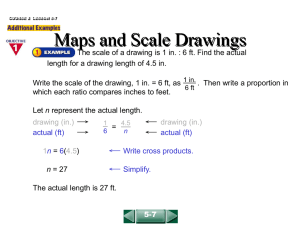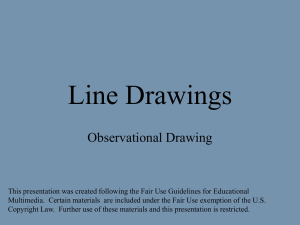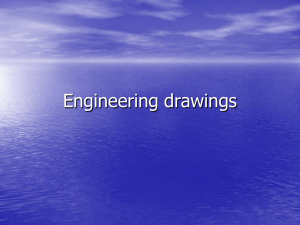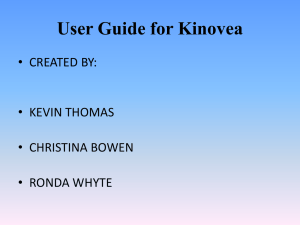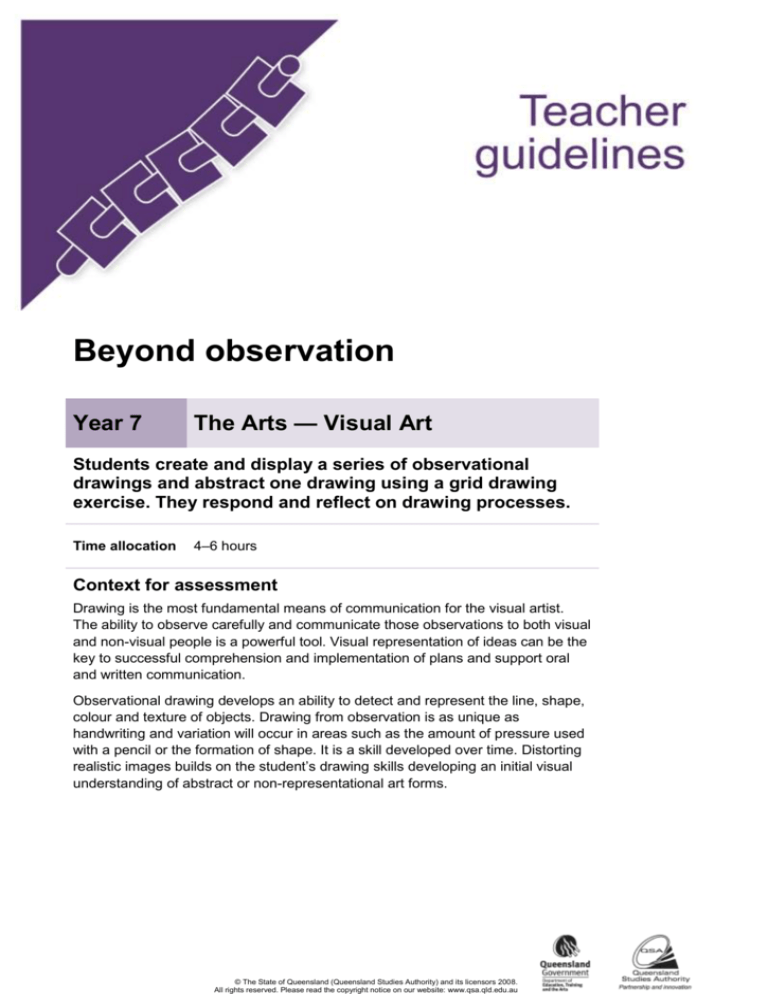
Beyond observation
Year 7
The Arts — Visual Art
Students create and display a series of observational
drawings and abstract one drawing using a grid drawing
exercise. They respond and reflect on drawing processes.
Time allocation
4–6 hours
Context for assessment
Drawing is the most fundamental means of communication for the visual artist.
The ability to observe carefully and communicate those observations to both visual
and non-visual people is a powerful tool. Visual representation of ideas can be the
key to successful comprehension and implementation of plans and support oral
and written communication.
Observational drawing develops an ability to detect and represent the line, shape,
colour and texture of objects. Drawing from observation is as unique as
handwriting and variation will occur in areas such as the amount of pressure used
with a pencil or the formation of shape. It is a skill developed over time. Distorting
realistic images builds on the student’s drawing skills developing an initial visual
understanding of abstract or non-representational art forms.
© The State of Queensland (Queensland Studies Authority) and its licensors 2008.
All rights reserved. Please read the copyright notice on our website: www.qsa.qld.edu.au
Teacher guidelines
This assessment gathers evidence of learning for the following Essential Learnings:
The Arts
Essential Learnings by the end of Year 7
Ways of working
Knowledge and understanding
Students are able to:
Visual Art
select and develop ideas for arts works,
considering intended audiences and
intended purposes, and make decisions
about arts elements and languages
create and shape arts works by modifying
arts elements to express purpose and to
include influences from their own and other
cultures and times
Visual Art involves modifying visual arts
elements, concepts, processes and forms
(both 2D and 3D) to express ideas,
considering intended audiences and
intended purposes, through images and
objects.
modify and polish arts works, using
interpretive and technical skills
Blended, controlled and symbolic colour is
used to create depth, representation and
symbolism.
present arts works to informal and formal
audiences for intended purposes, using
arts techniques, skills and processes
Descriptive and emotive lines are used to
create abstraction, proportion and
symbolism.
Negative space and positive shape are
used to create abstraction, nonrepresentation and proportion.
Actual, invented and simulated textures
are used to create depth, representation
and non-representation.
identify, apply and justify safe practices
respond by analysing and evaluating arts
works in social, cultural, historical and
spiritual contexts, using arts elements and
languages
reflect on learning, apply new
understandings and identify future
applications.
Assessable elements
Knowledge and understanding
Creating
Presenting
Responding
Reflecting
Source: Queensland Studies Authority 2007, The Arts Essential Learnings by the end of Year 7, QSA, Brisbane.
2
Year 7 The Arts — Visual Art: Beyond observation
Listed here are suggested learning experiences for students before attempting this assessment.
Discuss the purpose of observational drawing and experiment with observational drawing
skills.
Practise observational drawing using a selection of visual stimuli both familiar and unfamiliar
(e.g. manufactured artefacts, natural elements).
Participate in warm up exercises that involve observational drawing for short intervals of time
and then extending the time limit (e.g. 1 minute, 2–3 minutes, 5 minutes).
Practise drawing skills modifying the elements of line, colour, shape and texture and
experimenting with proportion, scale, tone and depth.
Experiment with types of drawings (e.g. contour drawings, tonal drawings, drawings with
colour).
Explore concepts of representation and abstraction.
Research noted abstract and distortion artists (e.g. Eko Nugroho, Lisa Rellana, Patricia Piccini,
Reg Mombasa (Mambo), Max Ernst, Salvador Dali, Magritte de Chirico).
Practise drawing with grid distortion (e.g. distort with waving lines, trapezoidal shapes,
elongated rectangles or other distortions).
Experiment with fragmenting a photocopy of an object that has been drawn.
Use a range of tools and materials for drawing (e.g. pencils, charcoal, crayons, pastels, pens
and watercolour pencils).
Develop an understanding of terminology (e.g. observational drawing, contour drawing, tonal
drawing, representation, abstraction, proportion, surrealism, distortion). See Appendix A: Visual
arts glossary and Appendix B: Word bank.
Explore a range of colour exercises using warm colours (e.g. yellow, red, orange), cool colours
(e.g. blue, green, purple), complementary colours (e.g. red, green) and monochromatic colour
schemes.
Experiment with formal and informal display (e.g. place images in different spaces and places,
vary visual arrangements, use different levels for specific purposes).
Respond and reflect on the practices used to produce a visual arts work, including a discussion
of elements.
Compose written responses, responding to and reflecting on visual arts elements, concepts
and materials.
3
Teacher guidelines
Teacher resources
Online coach to improve drawing skills: <www.drawingcoach.com>.
Contour drawing exercise:
<http://drawsketch.about.com/cs/drawinglessons/a/contourdrawing_2.htm>.
Lesson ideas for grid drawings and anamorphic art:
<www.princetonol.com/groups/iad/lessons/middle/grid-drawings.htm#Art>.
Helping children learn how to learn how to draw, Bartel, M 2000 (a short essay):
<www.goshen.edu/art/ed/westv.html>.
Introductory drawing activities:
<www.sasked.gov.sk.ca/docs/artsed/g5arts_ed/art/appendix_b.html>.
Art blog site discussing distortion in drawing: <www.nitaleland.com/project/distortion.htm>.
Preparing
Consider these points before implementing the assessment.
Teachers should consider what objects will be offered as stimulus for students to complete
their observational drawings.
4
Suggestions include: shoes, fruit, vegetables, bikes, cars, leaves, machinery, trees,
flowers, bottles, mugs, bags.
Prepare classroom for the assessment. Refer to Appendix C: Organising a Visual Art
classroom.
Year 7 The Arts — Visual Art: Beyond observation
Sample implementation plan
This table shows one way that this assessment can be implemented. It is a guide only — you may
choose to use all, part, or none of the table. You may customise the table to suit your students and
their school environment.
Suggested time
Student activity
Teacher role
Section 1. Observational drawings
2–3 hours
Select an object from the stimulus
provided by the teacher.
Provide a range of objects to suit group’s
interests.
Complete description and discussion of
object based on visual arts elements.
Remind students to draw what they see
not what they think they see.
Create three observational drawings:
Model description and discussion
response.
contour
tonal
colour — focusing on a
complementary or monochromatic
scheme.
Guide and assist as needed.
Organise peer feedback
Promote sensitivity in discussing other’s
drawings.
Complete questions about drawings.
Complete self and peer feedback
questions.
Section 2. Abstract drawing
1–2 hours
Create an abstract drawing using
distorted grid lines.
Display drawings.
Discuss distorted grid options.
Provide examples of distortion
techniques.
Guide students carefully through
instructions for creating a grid and
reinforce that the purpose is to enlarge
the original drawing to the maximum size
it can be on the cartridge paper.
When finished everyone should have a
different looking grid.
Section 3. Respond and reflect on drawings
30 minutes
Reflect on own drawings and those of
others by responding to questions in the
Student booklet.
Guide and assist as needed.
Promote sensitivity in discussing other’s
drawings.
Resources for the assessment
Appendix A
Visual arts glossary
Appendix B
Word Bank
Appendix C
Organising a Visual Art classroom
Equipment — pencils, charcoal, crayons, pastels, pens and watercolour pencils
5
Teacher guidelines
During the learning process, you and your students should have developed a shared
understanding of the curriculum expectations identified as part of the planning process.
After students have completed the assessment, identify, gather and interpret the information
provided in student responses. Use only the evidence in student responses to make your judgment
about the quality of the student learning. Refer to the following documents to assist you in making
standards-referenced judgments:
Guide to making judgments
Indicative A response
Sample responses (where available).
Making judgments about this assessment
Teachers should use all the drawings and annotations students have created in their Visual Art
journals as evidence for making judgments.
For further information, refer to the resource Using a Guide to making judgments,
available in the Resources section of the Assessment Bank website.
Evaluate the information gathered from the assessment to inform teaching and learning strategies.
Involve students in the feedback process. Give students opportunities to ask follow-up questions
and share their learning observations or experiences.
Focus feedback on the student’s personal progress. Emphasise continuous progress relative to
their previous achievement and to the learning expectations — avoid comparing a student with
their classmates.
Giving feedback about this assessment
This assessment contains peer feedback discussions at the end of each section. Teachers should
ensure that students are aware of issues of sensitivity when discussing the work of others.
Students will receive valuable feedback to guide their creative processes.
Teachers may choose to give individual feedback to students as they complete their drawings or
whole class comments as needed.
For further information, refer to the resource Using feedback, available in the
Resources section of the Assessment Bank website.
6
Appendix A
Visual arts glossary
Visual arts elements
Drawing
A visual art form that is concerned with the manipulation of wet or
dry media on a two-dimensional or three-dimensional surfaces.
Drawings may be observational, linear, positive and negative,
textural or tonal.
Observational drawings
Representing aspects of the world through looking and drawing what
is seen.
Tone
A visual art and design concept depicting the variation of light and
dark on a surface. Tone may be created through the techniques of
shading, stippling and cross-hatching.
Tonal drawing
Drawings focusing upon the manipulation of tone to create the
illusion of a three-dimensional image on a two-dimensional surface.
Contour
The outline or edge of a shape or form.
Contour drawing
Drawings created with a single line that defines the outer edge as
well as the inner forms (contours) of the subject.
Abstraction
The reliance on formal qualities such as line, colour and surface
rather than subject matter such as the figure.
Little or no attempt is made to represent images realistically, and
objects are often simplified or distorted.
Representational
Substitution for reality where the artist's intention is to present again
or represent a particular subject, i.e. a realistic portrayal of subject
matter.
Non-representational
Art that does not depict recognisable figures or elements of the
natural world. Non-representational art can be abstract, nonobjective and decorative.
Proportion
A visual art and design concept referring to the size relationships of
specific parts and to the overall composition.
Surrealism
A movement in art and literature from the 1920s, involving the
combination of images that would not normally be found together, as
if in a dream or above or beyond reality.
Distortion
Alteration in shape and/or proportions of an image.
Appendix A
Visual arts glossary (continued)
Visual arts elements
Texture
An element of visual art and design that refers to the tactile or visual
surface of an artwork.
Line
An element of visual art and design that exists as a two-dimensional
or three-dimensional path made by pencils, paint, string or wire.
Colour
A visual art and design element that refers to the hue, saturation or
value of colours. Hue refers to the name of the colour. Saturation
refers to the intensity of colour, how strong or weak it is.
Value refers to the lightness or darkness of a colour. Colours can be
described as being warm (red, orange, and yellow) or cool (blue,
green, and purple).
Complementary colours — colours opposite one another on the
colour wheel. In artworks colours such as red and green give a
visual balance or complementary effect.
Monochromatic colours — all the hues (tints and shades) of a
single colour.
Shape
A visual art and design concept that can be two-dimensional or
three-dimensional. When a line is extended to meet itself a shape is
created on a two-dimensional surface. (A three-dimensional shape
is referred to as a form.)
Shapes can also be:
positive (occupying space)
negative (blank space)
geometric — shapes are based on geometry, having regularities
and order (e.g. square, triangle, circle)
natural —based on organic forms, having irregularities and a
lack of order
abstract — based on the simplification, exaggeration or
distortion of shapes
non-objective — have no reference to any subject matter.
Adapted from: Visual Art Glossary, The Arts Years 1 to 10 Curriculum Materials, Queensland School Curriculum Council 2002 (CDROM) and <www.thefreedictionary.com/surrealism>.
Appendix B
Word bank
Colour
bright
dark
cold
contrast
deep
light
dull
earth
hue
intense
calm
pale
pastel
palette
pigment
warm
cool
rainbow
primary
secondary
shape
tints
dull
subdued
complementary
multicoloured
pale
shades
muted
clashing
polychrome
monochrome
Line
broken
flowing
broad
circular
straight
curved
dark
diagonal
contour
grid
hard
horizontal
light
linear
long
outline
angular
short
smooth
soft
spiralling
wide
sweeping
thick
thin
vertical
wiggly
zigzag
meandering
blurred
asymmetrical
symmetrical
geometric
large
small
natural
negative
simple
solid
tessellating
closed
open
heavy
light
linear
complex
distorted
massive
coarse
dry
feathery
furry
glossy
hard
matt
rough
scratchy
shiny
silky
slimy
smooth
soft
waxy
wet
actual
bumpy
corrugated
flat
gooey
leathery
prickly
sandy
simulated
sticky
tacky
velvet
Shape
organic
Texture
Adapted from: <www.princetonol.com/groups/iad/Files/crit3.htm>
Appendix C
Organising a Visual Art classroom
To make Visual Art a positive experience for all students, the following suggestions may be useful.
Students
Provide opportunities for students to work individually and with others.
Provide opportunities for students to work on different things at the same time and to continue
their explorations on subsequent occasions.
Ensure that students wear protective clothing such as closed-in shoes and old shirts for
painting.
Physical environment
Arrange desks, preferably in clusters, so that students can share tools and materials easily.
Allow for movement between desks.
Provide a clear area for display, taking into account the eye level of students and
accessibility.
Materials
Promote experimentation by supplying conventional and unconventional art materials.
Provide opportunities to participate in demonstrations of techniques and use of materials.
Use combinations of supplied and found materials.
Consider students’ abilities and skills needed to use tools.
Storage areas
Consider where ongoing projects will be kept (three-dimensional works may be kept on
shelves or lighter works may be suspended by lines).
Keep artwork easily accessible to students.
Teach students to respect each other’s work and to value diversity.
Cleaning up
Allocate jobs.
Teach students how to care for and maintain art equipment.
Have soap, water and paper towels available (clean buckets of water for hands and tools).
Allow sufficient time (be patient and give clear directions to students).
Time allocation and timing of activities
Consider how long sessions need to be to provide opportunities for students to complete
activities.
Consider any prior learning from other key learning areas that might be drawn on in the
activities. Consider whether or not particular knowledge or skills need to be revised.
Consider the sequence of activities needed to develop students’ knowledge, skills and
processes.
Prepare students in advance for what they will be doing in the subsequent session.




